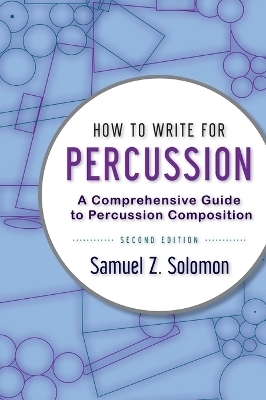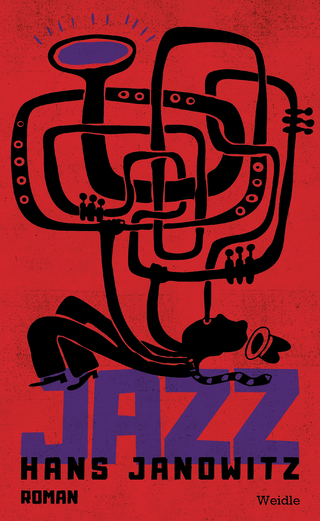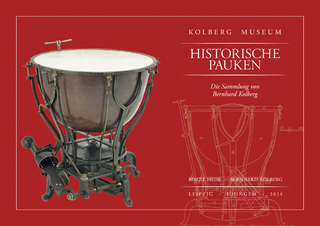
How to Write for Percussion
Oxford University Press Inc (Verlag)
978-0-19-992034-1 (ISBN)
While composers and percussionists are working more closely than ever with one another, there are few resources that address this collaborative relationship in depth. However, Samuel Z. Solomon, himself a percussionist and teacher, offers a comprehensive examination of the issues that percussionists and composers encounter in How to Write for Percussion. The first edition, self-published in 2004, provided musicians and music programs the world over with practical and indispensible information about issues of notation, concert production, and much more. This new edition goes even further as Solomon offers more insights derived from his personal experience as a percussionist and teacher and from his collaborations with other musicians.
The second edition of How to Write for Percussion expands the survey of behind-the-scenes processes-from instrument choice and notation to logistics, execution, and concert production-to uncover all the tools a composer needs to comfortably create innovative and skilled percussion composition. Solomon also includes more excerpts and performances as well as interviews with famous percussionists and composers that capture the intricacies of percussion composition. Moreover, the second edition features an expanded text with more instruments and more analysis, plus an extensive Online Video Companion containing over nine hours of videos with demonstrations, performances, interviews, and analysis to flesh out and clarify the material in the book. This updated edition of How to Write for Percussion will appeal to a wide swath of musicians including composers, arrangers, and percussionists. Those who have already utilized the first edition will welcome the upgrade, and those who have yet to benefit from Solomon's perspective will likewise find his insights illuminating.
Samuel Z. Solomon teaches percussion at The Boston Conservatory, Boston University, and The BU Tanglewood Institute. He is author of the acclaimed book, How To Write For Percussion, as well as three books on percussion playing and was curator of two collections of percussion etudes and solos. Solomon is founding member of the Yesaroun' Duo and the Line C3 percussion group, and is principal timpanist of the Amici New York chamber orchestra. Please visit www.szsolomon.com for more.
Table of Contents
Introduction
How This Book is Organized
Instruments Covered
Working with Percussionists
Location Specifics
The Value of Not Reading This Book
1. General Framework
A Dysfunctional Family
Comparison of Family Relationships
The Problem of Pitch
The Pitches of Percussion
The Validations and Limitations of Novelty
Three Methods for Indeterminately Pitch Instruments
The Written/Improv Divide
Expanding the Color Palette (to Shrink the Setup)
The Value of Improvised and Non-Notated Music
Social Composition
Write for People, Not Sounds
Write What is Wanted, Not What To Do
Working with Percussionists
2. General Logistics
Instrument Choice and Management
Six Stories, Three Sad and Three Happy
Why Use Fewer Instruments?
How to Consolidate
Inexpensive Instruments
Exotic Instruments
Electronic Percussion
Multiple Options for a Specified Instrument
Instruments Percussionists May Not Play
Multiple Percussionists
Section Setup
Orchestra
Wind Ensemble
Broadway Pit
Drum Corps and Marching Bands
Specialists
Non-Percussionists Playing Percussion
Chairs and Stands
Issues of Playability
Excessive Polyphony
How Fast Percussionists Can Play
Unidiomatic Writing-Music that Often Requires Memorization
Dynamics
Reaching Instruments
Instruments with Pedals
Physical Exertion and Shaking
Working with Headphones or Headset Microphones
3. General Notation
Basics of Percussion Parts and Scores
Instrument List
Instrument Key
Setup Diagram
Language
Parts
Cues
Percussion in the Conductor's Score
Dynamics
Designing a Notational System
Clefs
Staves
Noteheads
Mixing Determinately and Indeterminately Pitched Instruments
Key Signatures
What Goes Where on the Staff
The Chicken or the Egg?
Unspecified Instruments (Indeterminate Instrumentation)
How Much to Notate
Systems of Notation for Which There is No Standard
Return to a "Normal" Method of Playing
Note Length, Articulation, and Phrasing
Note Length Chart
Exact or Inexact Note-Length Indications
Muting (Muffling, Dampening)
Dead Stroke
Damper Pedals
Rolls
Notations that are Not Recommended
Symbol Notation
Altered Keyboard Notation (Timbre-Staff)
4. Beaters
To Indicate or Not to Indicate?
Beater Lingo
Logistical Beater Issues
Sticks
Mallets
Triangle Beaters, Knitting Needles
Brushes
Rute
Chime Hammers
Superball Mallet
Beaters as Instruments
Hands
Bows
5. Keyboard Percussion
Ranges and Construction
Writing for Keyboard Percussion
Stacked Instruments
Multiple Players
Extended Techniques
Miscellaneous
6. Drums
Sticks on Drums
Mallets on Drums
Hands on Drums
Playing on the Rim or Shell
Beating Spot
Mutes
Pitch Bending
Drum Size
Two-Headed Drums
Multiple Drums in Setups
Idiomatic Writing for Drums
Timpani
Tom-toms
Snare Drum, Field Drum, Tenor Drum
Concert Bass Drum, Pedal Bass Drum
Bongos, Congas
Timbales
Roto-Toms
Frame Drums
Tambourines
Djembe, Doumbek
Boobams
Drumset
7. Metal
Cymbals
Gongs
Finger Cymbals
Cowbells, Almglocken
Temple Bowls, Mixing Bowls
Brake Drums, Metal Pipes, Anvils, Bell Plates
Thundersheet
Junk Metal, Tin Cans, Pots and Pans
Ribbon Crasher
Spring Coil
Church Bells
Hand Bells
Steel Drums
Tambourines
Sleighbells
Metal Wind Chimes, Mark Tree, Bell Tree
Flexatone
Extended Techniques
8. Wood
Woodblocks, Templeblocks, Log Drum
Wooden Planks
Wood Drums, Wooden Boxes, Cajón, Mahler Hammer
Claves
Castanets
Rute
Guiro
Slapstick
Ratchet
Bamboo Wind Chimes
9. Miscellaneous Instruments
Bottles
Cabasa
Conch Shell
Crystal Glasses
Maracas, Shakers
Rainstick
Rice Bowls, Flower Pots
Sandpaper Blocks
Sirens
String Drum, Cuica
Stones, Prayer Stones
Thumb Piano
Vibraslap
Wind Chimes
Whistles
Wind Machine
Appendix A. Repertoire Analysis
Percussion Ensemble
Edgard Varèse, Ionisation (1929-31)
John Cage, Constructions (1939-1942)
Iannis Xenakis, Persephassa (1969)
Steve Reich, Drumming (1970-71)
Steve Mackey, It is Time (2010)
John Luther Adams, Inuksuit (2009)
Ryan Streber, Cold Pastoral (2004)
Nico Muhly, Ta & Clap (2004)
Adam Silverman, Naked and On Fire (2011)
Paul Lansky, Travel Diary (2007)
Orchestral
Bela Bartók
Sergei Prokofiev
Maurice Ravel
Gustav Mahler
Dmitri Shostakovich
Leonard Bernstein
Carl Nielsen
Jean Sibelius
Wind Ensemble
Smaller Mixed Ensemble
John Adams, Chamber Symphony (1992)
Stephan Hartke, Meanwhile (2007)
Jacob Druckman, Come Round (1992)
Charles Wuorinen, New York Notes (1982)
Pierre Boulez, Sur Incises (1996/1998)
Percussion Solo-Drums
Michio Kitazume, Side by Side (1991)
Elliott Carter, Eight Pieces for Four Timpani (1950/1966)
Casey Cangelosi, Meditation No. 1 (2011)
Percussion Solo-Keyboards
Jacob Druckman, Reflections on the Nature of Water (1986)
Paul Simon, Amulet (2008)
Steve Mackey, See Ya Thursday (1992)
Steve Swallow/Gary Burton, I'm Your Pal/Hullo Bolinas
Donald Martino, Soliloquy (2003)
Percussion Solo-Multi-Percussion
Iannis Xenakis, Psappha (1975)
David Lang, Anvil Chorus (1991)
Roger Reynolds, Watershed (1995)
Four Pieces for "Setup #1"
Nico Muhly, It's About Time (2004)
Michael Early, Raingutter (2007)
Marcos Balter, Descarga (2006)
Judd Greenstein, We Shall Be Turned (2006)
Percussion Concerto
James MacMillan, Veni Veni Emmanuel (1992)
Einojuhani Rautavaara, Incantations (2008)
Steven Mackey, Micro-Concerto (1999)
Orchestrating Native Sounds
Appendix B. Sample Setups
Appendix C. Extended Techniques
Return to a "Normal" Method of Playing
Manipulations of Timbre
Striking Unusual Parts of an Instrument
Unusual Usage of Beaters
Dead Stroke
Beating Spot
Bowing
Friction Roll
Scrape
Prepared Instruments
Pitch Bending
Vibrato
Adding Mass
Sympathetic Resonance
Clusters
Harmonics
Appendix D. Pitch Specification
Appendix E. Dynamics
Appendix F. Register
Appendix G. Beaters
Appendix H. Percussion Family Tree
Pitch Clarity Chart
Note Length Chart
Register Chart
Sound Production Chart
The Percussion Family Tree
| Erscheinungsdatum | 14.06.2016 |
|---|---|
| Verlagsort | New York |
| Sprache | englisch |
| Maße | 260 x 183 mm |
| Gewicht | 819 g |
| Themenwelt | Kunst / Musik / Theater ► Musik ► Instrumentenkunde |
| ISBN-10 | 0-19-992034-6 / 0199920346 |
| ISBN-13 | 978-0-19-992034-1 / 9780199920341 |
| Zustand | Neuware |
| Haben Sie eine Frage zum Produkt? |
aus dem Bereich


